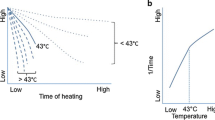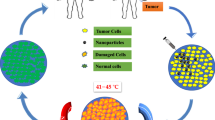Abstract
Hyperthermia is one of the methods for cancer therapies by creating artificial fever. Protection of healthy tissues around the tumor tissue, which has a high temperature, is one of the major issues in this treatment. In present study, the two-dimensional transient model of biological tissue with a tumor is taken into account. The area of the tumor is embedded with micro/nano superparamagnetic materials, and the surrounding healthy tissues are embedded with microcapsules of micro/nano-phase-change materials (PCMs). The effect of concentrations, the radius of the microcapsule, the melting temperature and latent heat of phase-change nanoparticles and also superparamagnetic nanoparticles on thermal protection were examined numerically by using the finite difference method. The results showed that the use of PCMs causes sensible decreases in temperatures of the healthy tissue around the cancerous cells (in some places up to 3 ℃) that leads to treatment complications reduction. If the protection of healthy tissues is well done, it is possible to raise the temperature of the cancerous tissue to achieve more favorable treatment.
















Similar content being viewed by others
Abbreviations
- \( C \) :
-
Heat Capacity (J/m3K)
- \( \varvec{E} \) :
-
Strength of Electric Field (V/m)
- \( f \) :
-
Frequency of Electromagnetic Field (Hz)
- \( h_{f} \) :
-
Apparent Heat Convection Coefficient between the Skin Surface and the Water (W/m2K)
- \( K \) :
-
Thermal Conductivity (W/mK)
- \( n \) :
-
Concentrations of Micro/Nanoparticles
- \( Q \) :
-
Heat Generation Rate (W/m3))
- \( R \) :
-
Radius of the Magnetic Induction Loop (m)
- \( r \) :
-
Radius of Micro/Nanoparticles (m)
- \( T_{ } \) :
-
Temperature (℃)
- t :
-
Time
- x, y :
-
Space Components
- \( \varepsilon \) :
-
Permittivity Dielectric Constant (C/N m2)
- \( \varepsilon \) :
-
Mean Absolute Error
- \( \eta \) :
-
Volume Ratio of Nanoparticles (1/m3)
- \( \mu_{0} \) :
-
Permeability of Free Space (T m/A)
- \( \sigma \) :
-
Electrical Conductivity (S/m)
- \( \chi \) :
-
Susceptibility of Magnetic Nanoparticles
- \( \omega_{b} \) :
-
Blood Perfusion Rate (1/s)
- \( \omega_{ } \) :
-
Relaxation Factor
- \( \Omega _{ } \) :
-
Solution Domain
- \( \Omega _{h} \) :
-
Heating Area
- p :
-
Iteration
- s :
-
Time Increment
- i, j :
-
Computational Nodes
- l :
-
Liquid
- s :
-
Solid
- 1:
-
Healthy Tissue Area
- 2:
-
Tumor Area with SPMs
- 3:
-
Healthy Tissue Area with PCMs
References
Andrä W, d’Ambly CG, Hergt R, Hilger I, Kaiser WA (1999) Temperature distribution as function of time around a small spherical heat source of local magnetic hyperthermia. J Magn Magn Mater 194(1–3):197–203
Cabuy E (2011) Hyperthermia in cancer treatment. Reliab Cancer Ther Energy Based Ther 1(2):1–48
Chung TJ (2010) Computational fluid dynamics. Cambridge University Press, Cambridge
De Santis V, Bit-Babik G, Feliziani M (2008) 3-D thermal model of vascularized tissues for hyperthermia treatment. In: 29th URSI General Assembly, pp 7–16
dos Santos I, Haemmerich D, da Silva Pinheiro C, da Rocha AF (2008) Effect of variable heat transfer coefficient on tissue temperature next to a large vessel during radiofrequency tumor ablation. Biomed Eng Online 7(1):21
Ferziger JH, Peric M (2012) Computational methods for fluid dynamics. Springer, Berlin
Ghosh S, Gupta DD, Chakraborty S, Das SK (2013) Superparamagnetic nanoparticle assisted hyperthermia and cooling protocol for optimum damage of internal carcinoma using computational predictive model. Heat Mass Transf 49(9):1217–1229. https://doi.org/10.1007/s00231-013-1162-7
Huang HW, Liauh CT, Shih TC, Horng TL, Lin WL (2010a) Significance of blood vessels in optimization of absorbed power and temperature distributions during hyperthermia. Int J Heat Mass Transf 53(25–26):5651–5662
Huang HW, Shih TC, Liauh CT (2010b) Predicting effects of blood flow rate and size of vessels in a vasculature on hyperthermia treatments using computer simulation. Biomed Eng Online 9(1):18
Khanafer K, Bull JL, Pop I, Berguer R (2007) Influence of pulsatile blood flow and heating scheme on the temperature distribution during hyperthermia treatment. Int J Heat Mass Transf 50(23–24):4883–4890
Li L, Yu B, Liang M, Yang S, Zou M (2014) A comprehensive study of the effective thermal conductivity of living biological tissue with randomly distributed vascular trees. Int J Heat Mass Transf 72:616–621
Liu KC, Chen HT (2009) Analysis for the dual-phase-lag bio-heat transfer during magnetic hyperthermia treatment. Int J Heat Mass Transf 52(5–6):1185–1192
Lv YG, Deng ZS, Liu J (2005) 3-D numerical study on the induced heating effects of embedded micro/nanoparticles on human body subject to external medical electromagnetic field. IEEE Trans Nanobiosci 4(4):284–294
Lv Y, Zou Y, Yang L (2012) Theoretical model for thermal protection by microencapsulated phase change micro/nanoparticles during hyperthermia. Heat Mass Transf 48(4):573–584
Majchrzak E, Paruch M (2001) Numerical modelling of the cancer destruction during hyperthermia treatment. In 19th International conference on computer methods in mechanics CMM-2011, Warsaw, Poland, Short Papers, pp 333–334
Majchrzak E, Paruch M (2009) Numerical modelling of temperature field in the tissue with a tumor subjected to the action of two external electrodes. Sci Res Inst Math Comput Sci 8(1):137–145
Majchrzak E, Paruch M (2010) Numerical modelling of tissue heating by means of the electromagnetic field. Sci Res Inst Math Comput Sci 9(1):89–97
Majchrzak E, Paruch M (2011) Application of evolutionary algorithms for identification of number and size of nanoparticles embedded in a tumor region during hyperthermia treatment. In: Burczyński T, Periaux J (eds) Evolutionary and deterministic methods for design, optimization and control with applications to industrial and societal problems, a series of handbooks on theory and engineering applications of computational methods. CIMNE, Barcelona, pp 310–315
Majchrzak E, Dziatkiewicz G, Paruch M (2008) The modelling of heating a tissue subjected to external electromagnetic field. Acta Bioeng Biomech 10(2):29–37
Majchrzak E, Turchan L, Jasiński M (2019) Identification of laser intensity assuring the destruction of target region of biological tissue using the gradient method and generalized dual-phase lag equation. Iran J Sci Technol Trans Mech Eng 43:1–10
Nemati Z, Alonso J, Martinez LM, Khurshid H, Garaio E, Garcia JA, Phan MH, Srikanth H (2016) Enhanced magnetic hyperthermia in iron oxide nano-octopods: size and anisotropy effects. J Phys Chem C 120(15):8370–8379
Ng EYK, Kumar SD (2017) Physical mechanism and modeling of heat generation and transfer in magnetic fluid hyperthermia through Néelian and Brownian relaxation: a review. Biomed Eng Online 16(1):36
Orndorff C, Ponomarev S, Dai W, Bejan A (2017) Thermal analysis in a triple-layered skin structure with embedded vasculature, tumor, and gold nanoshells. Int J Heat Mass Transf 111:677–695
Sarkar D, Haji-Sheikh A, Jain A (2015) Temperature distribution in multi-layer skin tissue in presence of a tumor. Int J Heat Mass Transf 91:602–610
Taheri AA, Talati F (2019). Numerical study of induction heating by micro/nano magnetic particles in hyperthermia. J Comput Appl Res Mech Eng (JCARME), Articles in Press, Accepted Manuscript, Available Online from 20 February 2019
Talati F, Taheri AA (2019) Uncertainty analysis in induction heating by magnetic micro/nanoparticles during hyperthermia, Tabriz Mech Eng, (in Persian)
Tang YD, Jin T, Flesch RC (2018) Impact of different infusion rates on mass diffusion and treatment temperature field during magnetic hyperthermia. Int J Heat Mass Transf 124:639–645
van der Zee J, González D, van Rhoon GC, van Dijk JD, van Putten WL, Hart AA (2000) Comparison of radiotherapy alone with radiotherapy plus hyperthermia in locally advanced pelvic tumours: a prospective, randomised, multicentre trial. Lancet 355(9210):1119–1125
Wang H, Dai W, Bejan A (2007) Optimal temperature distribution in a 3D triple-layered skin structure embedded with artery and vein vasculature and induced by electromagnetic radiation. Int J Heat Mass Transf 50(9–10):1843–1854
Yuan P (2009) Numerical analysis of an equivalent heat transfer coefficient in a porous model for simulating a biological tissue in a hyperthermia therapy. Int J Heat Mass Transf 52(7–8):1734–1740
Yue K, Xu P, Zhang X (2012) Study on the effective diffusion coefficient of nano-magnetic fluid and the geometrical factors in tumor tissues. Heat Mass Transf 48(2):275–282. https://doi.org/10.1007/s00231-011-0880-y
Author information
Authors and Affiliations
Corresponding author
Rights and permissions
About this article
Cite this article
Taheri, A.A., Talati, F. FDM-based 2D Numerical Study of Hyperthermia Cancer Treatment by Micro/Nano-Phase-Change Materials. Iran J Sci Technol Trans Mech Eng 44, 1077–1089 (2020). https://doi.org/10.1007/s40997-019-00314-y
Received:
Accepted:
Published:
Issue Date:
DOI: https://doi.org/10.1007/s40997-019-00314-y




